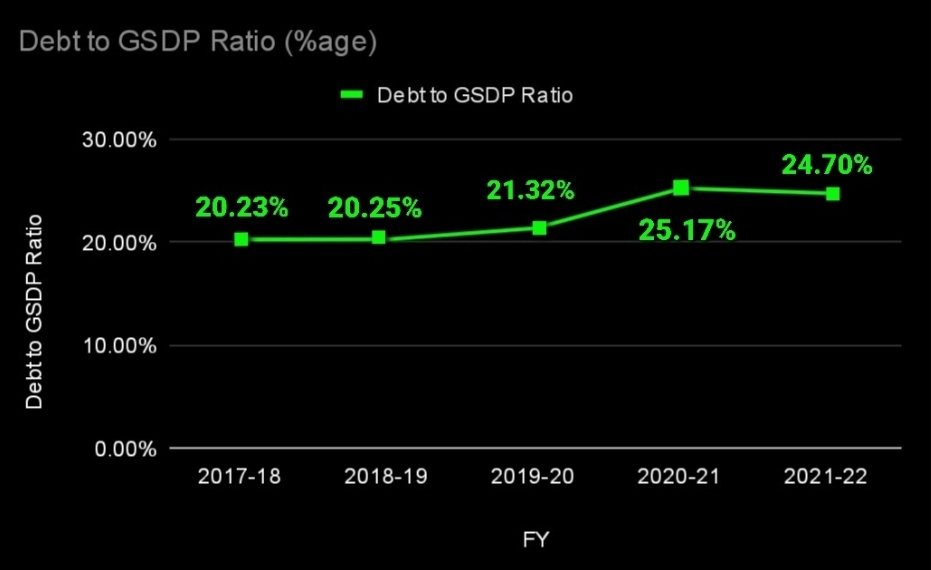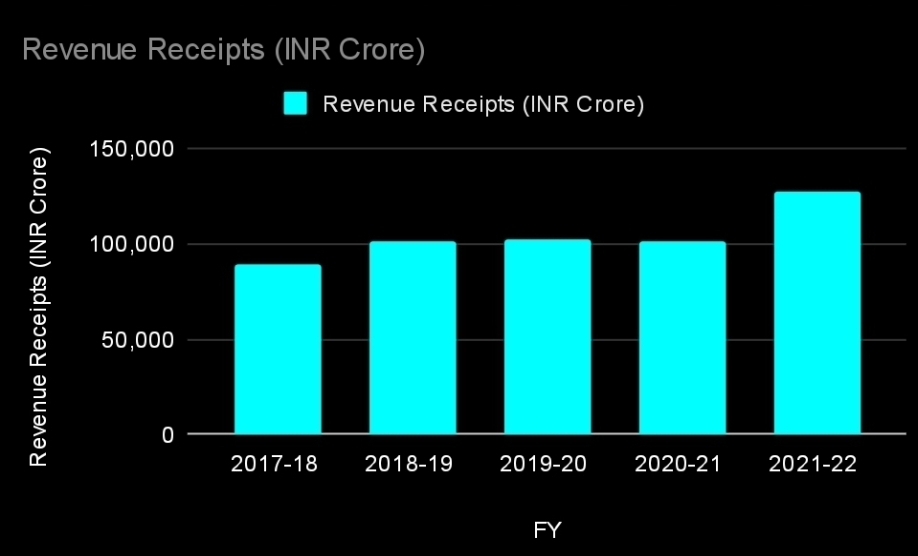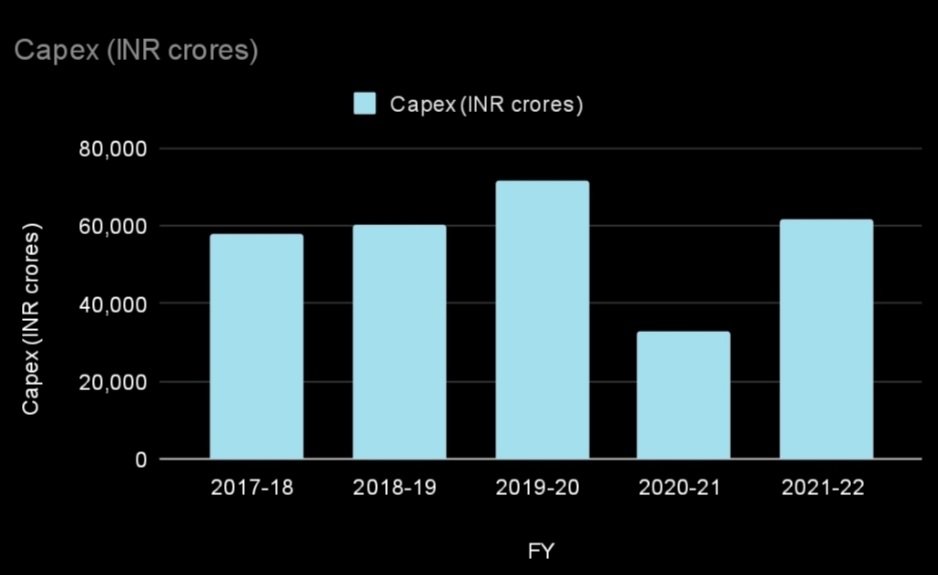
Fiscal Analysis of recently formed States: TELANGANA
The State in consideration for this article in the series, is the newest formed amongst all the others, and yet has consistently been rising the ranks to stand among the top performing Indian states. Telangana officially came into being in June 2014, and by 2022-23 came out with the highest per capita income among all other states. Since 2016, its economy has grown at an average annual growth rate of 13.9%.
Recently in 2022, the RBI announced Telangana to be the 7th largest contributor to India’s economy by Net State Value Added. In FY22, it also ranked third in terms of its software exports, with a 15.6% share of the whole country’s IT exports, only behind the powerhouses of Karnataka and Maharashtra.
Although Telangana largely benefitted from its separation from Andhra Pradesh in 2014, chiefly due to it getting the ownership share of majority assets in the vastly developed city of Hyderabad, it cannot be ignored that the Telangana government has taken several important steps to ensure the economy remains on its success trajectory.
Continuing our series of analyzing newly formed states, we will use the Debt to GSDP ratio, Capital Expenditure and Ease of Doing Business as key indicators to study the state’s fiscal management, steps towards the creation of a strong business ecosystem, as well as its commitment to the welfare state ideal and how it caters to its people’s education and health needs. We will do this, while taking a holistic view towards the economy and social development conditions in the state.
- Debt to GSDP Ratio
The ratio displays the total debt burden or liabilities of the state with respect to its Gross State Domestic Product, in percentage terms. It’s a sign of fiscal health and stability of the government, where a very high Debt to GSDP Ratio can lead to inflationary pressures and run the risk of a recession, with fewer investments to boost economic growth and higher interest payments that drain the government’s resources.
Telangana has done extraordinarily well on this front, ensuring to keep the ratio below the 25% limit advised by the FRBM Act of 2005. The limit was breached only during FY 2020-21, which is consistent with other states as well and can be attributed to the undertaking of more debt due to the Covid-19 crisis. The revised estimates for 2022-23 project a ratio of 27.3%, which although is on the higher side, remains to be the lowest among all five South Indian states.

However, it is pertinent for the government to lower the debt burden in subsequent years, with the Centre posing debt ceilings to infuse the sentiment further, it will be key to manage expenditures from its own resources.
It is also noteworthy that the fiscal deficit for FY22 was 3.94% which was also under the limits of the Centre advised 4% for that year.
Similarly, the revised estimates of FY 2023-24 for fiscal deficit are 3.2% which are lower than the Centre prescribed 3.5% for this year.

The revenue receipts of the state after a bout of stagnation during 2018 to 2021, have now increased to INR 127,489 crore in 2021-22.
A latest report by PRS showed a 30.6% increase in 2023-24 compared to the revised estimates of 2022-23. If this increase in revenue receipts is sustainable, it is expected to ensure a control over the rising debt burden. Moreover, correlation between the net Gross Value Added and Debt data shows that the borrowed funds have been used productively. These trends overall indicate a healthy Debt to GSDP ratio and fiscal condition of the state that has optimally contributed to an increase in the GSDP as well (11.2% increase in FY22).
- Capital Expenditure (Capex)
The area where Telangana has shown most promise, capital expenditure shows the amount of funds allocated towards the creation of new assets. The increased spending leads to the development and construction of roads, bridges, irrigation projects and more.
Post the sudden drop in Capex in 2020-21, capex in FY 2021-22 was 7% lower than the initial 2019-20 figures, yet the increased spending by 87%, was the highest jump in the country. According to RBI’s FY2022 data, Telangana ranks fifth among all states in terms of total capital expenditure.

In contrast to the last two states we analysed namely Chhattisgarh and Uttarakhand, who had education and health among their top three expenditure priorities, Telengana differs with Agriculture and allied activities, Social Welfare of minority communities and Nutrition as its top avenues for fund allocation.
This can be attributed to the fact that the largest portion of its labour force (about 46%) is engaged in agriculture. Post 2021, the trend seems to be reserving with Education, Arts and Culture being given more priority in terms of expenditure owing to the rising cost of education in the state.
The previously allocated low funds did not harm the education levels too adversely as we can see that the GER, or Gross Enrollment Ratio for higher secondary education in Telangana was considerably higher than most other states. As of 2022, it stood at 64.8% which is even higher than the prescribed 50% target of NEP 2020. This is also higher than the also newly formed states of Chhattisgarh and Uttarakhand studied in previous articles of this series. The GER for degree level higher education stood at 35.6% n 2019-20, which is although below the NEP targets, is still above the national average of 27.1%.
Another interesting metric to judge the education system in the state is the student to teacher ratios, which were at a comfortable 34 for higher secondary grades and 25 for secondary grades in 2019-20.
Although an article by Economic and Political Weekly, comparing per capita expenditure on education between Andhra Pradesh and Telangana, found the latter underperforming on almost all fronts. Telangana also has a per capita income which was the highest in the country at INR 3.17 Lakhs (2021), which compensated for the low state expenditure on education. It can also be said that this high per capita income was the cause behind heavy privatization of the sector that has now increased costs. This cost push inflation can be said to be provoking the state to increase its education spending in recent years.
Similarly on the healthcare front, it was not and still is not among the top three expenditure priorities for the state government, ranking fourth in 2022 among all avenues for the same. However, the total share of healthcare amongst other avenues in total expenditure is still the highest in South India. Telangana ranked 3rd among all Indian states with lowest burden on the public for health expenditure and 3rd also in reducing the maternal mortality rate which was brought down from 91 to 56 after gaining statehood. The healthcare system in Telangana is well trusted to the degree that despite a high per capita income, 60% deliveries in the state are in public hospitals.
- Ease of Doing Business
Business is another front on which Telangana has shown a stellar performance. The state stood 13th in 2015 in just the second year of its independent statehood. However, through the years, Telangana ranked 1st in 2017, 2nd in 2019 and 3rd in 2021.
A large part of this can be attributed to the government’s efforts in decentralizing the IT sector away from Hyderabad to other districts like Warangal, Mahabubnagar, Warangal, Nizamabad and Karimnagar, by creating plug-and-play facilities of each about 50,000 sqft.
The importance of IT in Hyderabad can be exhibited by the simple fact that its IT exports were valued at USD 23 Billion in FY22. IT exports account for 50% of total exports from the state.
Concluding Remarks
In review of the above points, it can be unequivocally said that Telangana is not just a rising but already well-established state with a commendable set of accomplishments to its administration’s credit.
The few concerns for its economy are, however, still significant. The key one among them is unemployment. The state recorded a 10.2% urban unemployment in 2022 which accounted for an overall rate of 7.7% after including the rural rate of 5.2%. Many estimates have pointed the reasons for this to high competition in the job market. The government has subsequently called for more investment in the state to increase the number of jobs.
A more keenly visible trend is also the government’s focus which is more towards social welfare and minority driven schemes that give freebies for the lower privileged classes. Several schemes like the Dalit Bandhu, Rhythu Bandhu have been criticized by experts for putting a strain on resources that can be better utilized for investments towards job creation and public infrastructure projects. The same can be said, bringing out the earlier remarks about unemployment, where the government in 2023 announced an allowance of INR 3016 for every unemployment educated youth in the state.
Although challenges like this persist, the truth remains that Telangana has maintained a fine balance between social welfare services and more investment driven capitalistic inclinations. It is still one among the best performing states in the country and will in all likelihood, continue the trend of further investment and export proliferation in coming years.
Aarya Gandre
Aarya Gandre is a Research Intern at Tatvita Analysts. He is pursuing his Bachelors in Economics.

